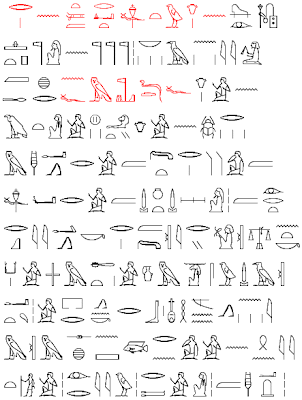

Ancient Egyptian Writing - Understanding Hieroglyphs
The Grammar of Hieroglyphs
Ancient Egyptian writing consists of phonetic glyphs, logograms and determinatives.
Most signs are phonetic in nature, meaning it is read as a sound independent of its visual characteristics. A phonetic glyph can sound as one consonant (mono or uniliteral) or a combination of two (biliteral signs) or three (triliteral signs) consonants. Egyptian hieroglyphic writing does not normally indicate vowels. In modern transcriptions an e is added between consonants to aid in their pronunciation. For example, nfr "good" is typically written nefer.
A very common ocurrence in ancient Egyptian writing is the phrase ntr ntrw, meaning "god of gods" as in "Amen Re God of Gods". In the movie "Stargate", the Egyptologist played by James Spader seizes an opportunity to figure out the correct pronunciation of this epithet. The "Egyptian" woman next to him when he's reading the glyphs tells him the "right" pronunciation is "Nater Naturu" but, then again, this is Hollywood.
The uniliteral signs below make up the so-called hieroglyphic alphabet. Egyptians never simplified their complex writing into a true ancient Egypt alphabet.
Logograms are single written symbols that represent an entire word or phrase without indicating their pronunciation.
Determinatives are placed at the end of the word. These characters serve to clarify the meaning of the word. Divinities, humans, parts of the human body, animals and plants are some of the most common determinatives.
Visually, ancient Egyptian writing is more or less figurative. The symbols represent real or imaginary elements, sometimes stylized and simplified, but all generally perfectly recognizable in form. However, the same sign can mean an object or an abstract idea.
Ancient Egyptian language is written from right to left, from left to right, or from top to bottom, the usual direction being from right to left. The reader must consider the direction in which the asymmetrical hieroglyphs are turned in order to determine the proper reading order. For example, when human and animal pictures face to the right they must be read from right to left, and vice versa.
Like many ancient writing systems, words are not separated by blanks or by punctuation marks.
A definitive ortography was never developed, and ancient Egyptian scribes considered the artistic aspects of the hieroglyphs in their spelling, including redundancies, adding several characters with the same sounds, to guide the reader or to fill up empty space.
Egyptologists have compiled some basic grammatical rules.
Nouns are always accompanied by a mute vertical stroke indicating their status as a logogram.
The feminine form of a word has the suffix (t).
The doubling of a sign indicates its dual; the tripling of a sign indicates its plural.
The plural is also formed by adding the suffix or (w).
Offensive characters, funerals, taboos, rare or complex, can be replaced by a slanted stroke.
The two last names of the reigning pharaoh are always placed within a cartouche.
discovery at rosetta book by jonathan downsAs writing developed and became more widespread among the Egyptian people, simplified glyph forms developed, resulting in the hieratic (priestly) and demotic (popular) scripts. These variants were also more suited than the elaborate pictures for use on papyrus. Hieroglyphic writing was not, however, eclipsed, but existed along side the other forms, especially in monumental and other formal writing. The Rosetta Stone contains parallel texts in hieroglyphic and demotic writing.
The breakthrough in decipherment of ancient Egyptian writing was done by Thomas Young and Jean-François Champollion beginning in the early 1800s. The discovery in 1799 of the Rosetta Stone provided the critical information which allowed Champollion to discover the nature of the hieroglyphic script by the 1830s.
This was a major triumph for the young discipline of Egyptology.
source : www.all-about-egypt.com/understanding-hierogl..
source picture : http://hieroglyphs.net/000501/html/000-044.html






Posting Komentar